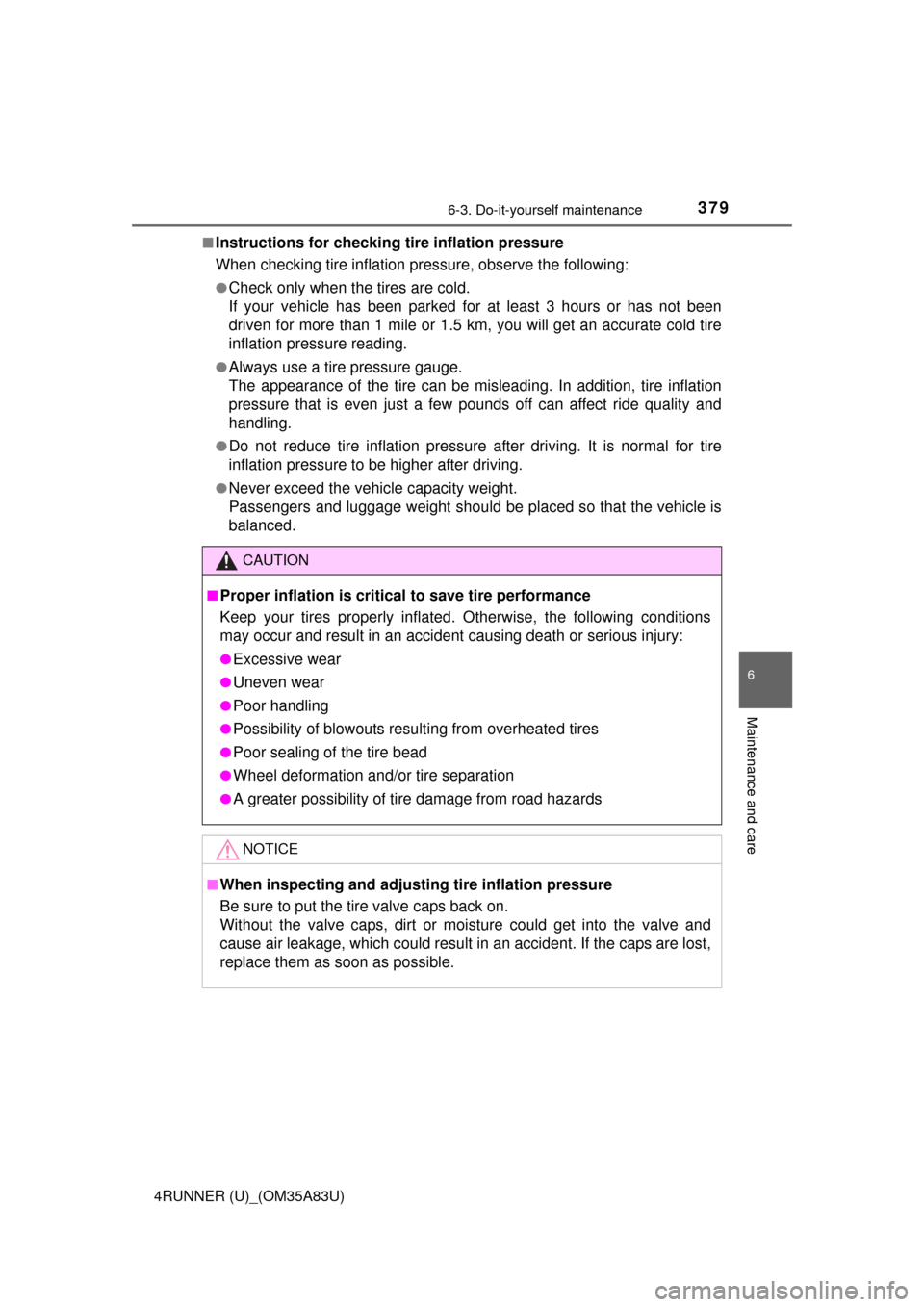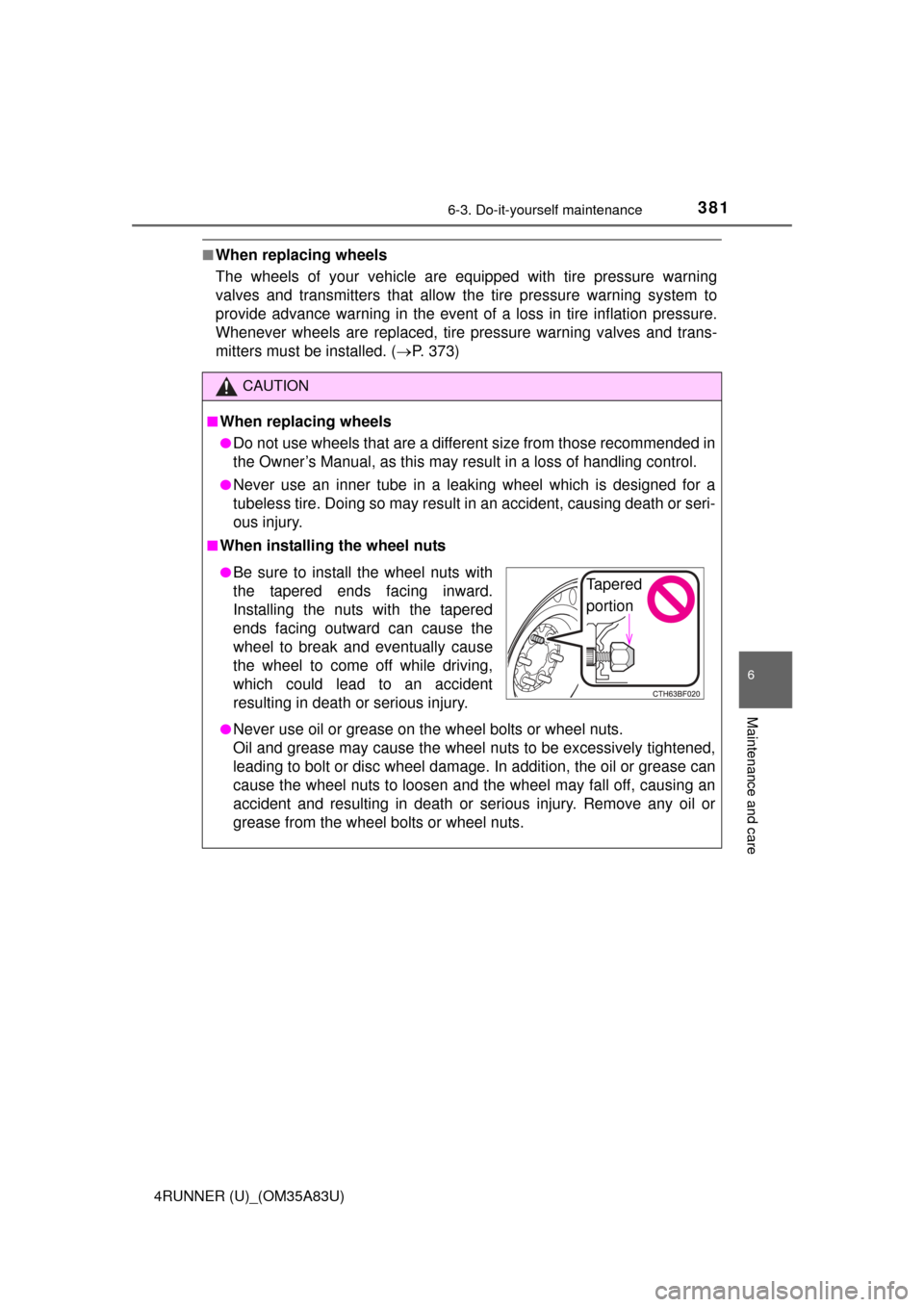Page 381 of 530

3796-3. Do-it-yourself maintenance
6
Maintenance and care
4RUNNER (U)_(OM35A83U)■
Instructions for checking tire inflation pressure
When checking tire inflation pressure, observe the following:
●Check only when the tires are cold.
If your vehicle has been parked for at least 3 hours or has not been
driven for more than 1 mile or 1.5 km, you will get an accurate cold tire
inflation pressure reading.
●Always use a tire pressure gauge.
The appearance of the tire can be misl
eading. In addition, tire inflation
pressure that is even just a few p ounds off can affect ride quality and
handling.
●Do not reduce tire inflation pressure after driving. It is normal for tire
inflation pressure to be higher after driving.
●Never exceed the vehicle capacity weight.
Passengers and luggage weight should be placed so that the vehicle is
balanced.
CAUTION
■Proper inflation is critical to save tire performance
Keep your tires properly inflated . Otherwise, the following conditions
may occur and result in an accident causing death or serious injury:
●Excessive wear
●Uneven wear
●Poor handling
●Possibility of blowouts result ing from overheated tires
●Poor sealing of the tire bead
●Wheel deformation and/or tire separation
●A greater possibility of tire damage from road hazards
NOTICE
■When inspecting and adjusting tire inflation pressure
Be sure to put the tire valve caps back on.
Without the valve caps, dirt or moisture could get into the valve and
cause air leakage, which could result in an accident. If the caps are lost,
replace them as soon as possible.
Page 383 of 530

3816-3. Do-it-yourself maintenance
6
Maintenance and care
4RUNNER (U)_(OM35A83U)
■When replacing wheels
The wheels of your vehicle are equipped with tire pressure warning
valves and transmitters that allow the tire pressure warning system to
provide advance warning in the event of a loss in tire inflation pressure.
Whenever wheels are replaced, tire pressure warning valves and trans-
mitters must be installed. ( P. 373)
CAUTION
■When replacing wheels
●Do not use wheels that are a different size from those recommended in
the Owner’s Manual, as this may result in a loss of handling control.
●Never use an inner tube in a leak ing wheel which is designed for a
tubeless tire. Doing so may result in an accident, causing death or seri-
ous injury.
■When installing the wheel nuts
●Never use oil or grease on the wheel bolts or wheel nuts.
Oil and grease may cause the wheel nuts to be excessively tightened,
leading to bolt or disc wheel damage. In addition, the oil or grease can
cause the wheel nuts to loosen and the wheel may fall off, causing an
accident and resulting in death or serious injury. Remove any oil or
grease from the wheel bolts or wheel nuts.
●Be sure to install the wheel nuts with
the tapered ends facing inward.
Installing the nuts with the tapered
ends facing outward can cause the
wheel to break and eventually cause
the wheel to come off while driving,
which could lead to an accident
resulting in death or serious injury.Tapered
portion
Page 387 of 530
3856-3. Do-it-yourself maintenance
6
Maintenance and care
4RUNNER (U)_(OM35A83U)
●Flathead screwdriver
● Small flathead screwdriver
● Lithium battery CR2016 (vehicles without a smart key system), or
CR1632 (vehicles with a smart key system)
Remove the cover.
To prevent damage to the key,
cover the tip of the screwdriver with
a rag.
Remove the module.
Open the case cover using a
coin protected with tape etc.
and remove the depleted bat-
tery.
Insert a new battery with the “+”
terminal facing up.
Wireless remote control/electronic key bat-
ter y
Replace the battery with a new one if it is depleted.
You will need the following items:
Replacing the battery (vehicl es without a smart key system)
1
2
3
Page 409 of 530

407
When trouble arises7
4RUNNER (U)_(OM35A83U)7-1. Essential information
Emergency flashers .......... 408
If your vehicle has to be stopped in an
emergency ...................... 409
7-2. Steps to take in an emergency
If your vehicle needs to be towed ......................... 411
If you think something is wrong .............................. 416
Fuel pump shut off system ............................ 417
If a warning light turns on or a warning buzzer
sounds ............................ 418
If a warning message or indicator is
displayed......................... 426
If you have a flat tire.......... 433
If the engine will not start ........................... 446
If the shift lever cannot be shifted from P............. 448
If you cannot operate back door opener .................... 449
If the electronic key does not operate properly........ 450
If the vehicle battery is discharged ...................... 452
If your vehicle overheats ... 455
If the vehicle becomes stuck ............................... 458
Page 413 of 530

411
7
When trouble arises
4RUNNER (U)_(OM35A83U)
7-2. Steps to take in an emergency
The following may indicate a problem with your transmission. Contact
your Toyota dealer before towing.
●The engine is running but the vehicle will not move.
● The vehicle makes an abnormal sound.
If a tow truck is not available in an
emergency, your vehicle may be
temporarily towed using a cable or
chain secured to the emergency
towing eyelet(s). This should only
be attempted on hard surfaced
roads for short distances at low
speeds.
A driver must be in the vehicle to
steer and operate the brakes. The
vehicle’s wheels, drive train,
axles, steering and brakes must
be in good condition.
If your vehicle needs to be towed
If towing is necessary, we re commend having your vehicle
towed by your Toyota dealer or a commercial towing service,
using a lift-type truc k or flat bed truck.
Use a safety chain system for all towing, and abide by all state/
provincial and local laws.
Before towing
Emergency towing
Page 416 of 530
4147-2. Steps to take in an emergency
4RUNNER (U)_(OM35A83U)
If you use chains or cables to tie
down your vehicle, the angles
shaded in black must be 45.
Do not overly tighten the tie
downs or the vehicle may be dam-
aged.
■ Before emergency towing
Vehicles without a smart key system: Turn the engine switch to the “ACC”
(engine off) or “ON” position.
Vehicles with a smart key system: Turn the engine switch to ACCES- SORY (engine off) or IGNITION ON mode (engine running).
Part-time 4WD models:
Type A
Shift the front-wheel drive control lever to H2.
Type B
Push the “UNLOCK” button and turn the front-wheel drive control switch
to H2.
Full-time 4WD models: Push the “ UNLOCK” button and turn the four-
wheel drive control switch to H4F. (The center differential is unlocked.)
Shift the shift lever to N.
Release the parking brake.
Using a flat bed truck
1
2
3
4
Page 418 of 530
4167-2. Steps to take in an emergency
4RUNNER (U)_(OM35A83U)
●Fluid leaks under the vehicle.
(Water dripping from the air co nditioning after use is normal.)
● Flat-looking tires or uneven tire wear
● Engine coolant temperature gauge needle continually points higher
than normal.
● Changes in exhaust sound
● Excessive tire squeal when cornering
● Strange noises related to the suspension system
● Pinging or other noises related to the engine
● Engine missing, stumbling or running roughly
● Appreciable loss of power
● Vehicle pulls heavily to one side when braking
● Vehicle pulls heavily to one side when driving on a level road
● Loss of brake effectiveness, spon gy feeling, pedal almost touches
the floor
If you think something is wrong
If you notice any of the follow ing symptoms, your vehicle proba-
bly needs adjustment or repair. Contact your Toyota dealer as
soon as possible.
Visible symptoms
Audible symptoms
Operational symptoms
Page 419 of 530
4177-2. Steps to take in an emergency
7
When trouble arises
4RUNNER (U)_(OM35A83U)
Follow the procedure below to restart the engine after the system is
activated.
Vehicles without a smart key system
Turn the engine switch to the “ACC” or “LOCK” position.
Restart the engine.
Vehicles with a smart key system
Turn the engine switch to ACCESSORY mode or turn it off.
Restart the engine.
Fuel pump shut off system
To minimize the risk of fuel leakage when the engine stalls or
when an airbag inflates upon collision, the fuel pump shut off
system stops the supply of fuel to the engine.
NOTICE
■Before starting the engine
Inspect the ground under the vehicle.
If you find that fuel has leaked onto the ground, the fuel system has been
damaged and is in need of repair. Do not restart the engine.
1
2
1
2